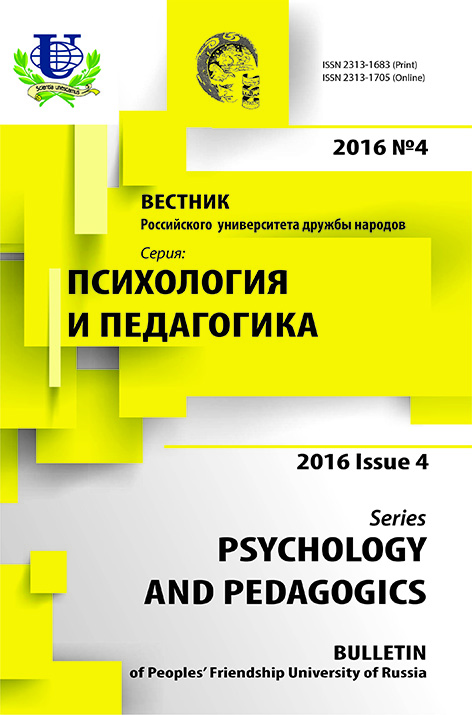КРЕАТИВНОСТЬ И КОНВЕРГЕНТНОЕ МЫШЛЕНИЕ: ОТРАЖЕНИЯ, СООТНОШЕНИЯ И ПРАКТИЧЕСКИЕ ПРИЛОЖЕНИЯ
- Авторы: Любарт Т.1
-
Учреждения:
- Университет Декарта (Париж V) Институт психологии
- Выпуск: № 4 (2016)
- Страницы: 7-15
- Раздел: Статьи
- URL: https://journals.rudn.ru/psychology-pedagogics/article/view/15105
- DOI: https://doi.org/10.22363/2313-1683-2016-4-7-15
Цитировать
Полный текст
Аннотация
Креативность понимается как способность генерировать новые, оригинальные идеи, которые имеют смысл и ценность в их контексте. Теоретики часто обсуждают роль дивергентного и конвергентного мышления в развитии и функционировании креативности. В данной статье внимание сосредоточено на конвергентном мышлении и способах его концептуализации и операционализации. Установлено, что некоторые из рассматриваемых концепций в большей степени соответствуют пониманию креативности. Представлены и обоснованы некоторые новые способы диагностики конвергентного мышления, которые могут быть использованы для измерения креативности. В частности, описана тестовая батарея «Оценка потенциала креативности» (EpoC), являющаяся новым релевантным инструментом для оценки конвергентного мышления с акцентом на интегративный и оригинальный синтез, который является самым существенным для креативных процессов и обеспечивает возможности для генерации творческих продуктов. Обсуждаются практические приложения данной проблемы в сфере психодиагностики креативности и в образовании.
Ключевые слова
Об авторах
Тодд Любарт
Университет Декарта (Париж V) Институт психологии
Автор, ответственный за переписку.
Email: psyj@rudn.university
71 avenue Edouard Vaillant 92100 Boulogne-Billancourt Cedex France
Список литературы
- Beghetto R. & Kaufman J.C. Toward a broader conception of creativity. Psychology of Aesthetics, Creativity and the Arts, 2007, vol. 1, no 2, pp. 73-79.
- Cropley A. In praise of convergent thinking. Creativity Research Journal, 2006, vol. 18, no 3, pp. 391-404.
- Finke R.A., Ward T.B. & Smith S.S. Creative cognition: Theory, research, and applications, Cambridge (MA), MIT Press, 1992.
- Guilford J.P. Creativity. American Psychologist, 1950, vol. 5, pp. 444-454.
- Guilford J.P. Structure of intellect. Psychological Bulletin, 195), vol. 53, pp. 267-293.
- Guilford J.P. The nature of human intelligence, New York, McGraw-Hill, 1967.
- Guilford J.P. Intelligence, creativity, and their educational implications, San Diego, (CA), Robert Knapp, 1968.
- Isaksen S.G. & Treffinger D.J. Creative problem solving: The basic course, Buffalo (NY), Bearly Limited, 1985.
- Koestler A. The act of creation, New York, Macmillan, 1964.
- Lubart T.I. Creativity, In R.J. Sternberg (ed.), Thinking and problem solving. New York, Academic Press, 1994, pp. 289-332.
- Lubart T.I. Models of the creative process: Past, present and future. Creativity Research Journal, 2000, vol. 13, no 3-4, pp. 295-308.
- Lubart T.I. In search of creative Intelligence, in R.J. Sternberg, J. Lautrey, & T.I. Lubart (eds.), Models of intelligence: International perspectives. Washington DC, American Psychological Association, 2003, pp. 279-292.
- Lubart T.I., Besancon M. & Barbot B. Evaluation of Potential Creativity. Paris: Hogrefe, 2011.
- Lubart T.I., Pacteau C., Jacquet A-Y. & Caroff X. Children’s creative potential: An, empiricalstudy of measurement issues. Learning and Individual Differences, 2010, vol. 20, no 4, pp. 388-392.
- Ma H.H. A synthetic analysis of the effectiveness of single components and packages in creativity training programs. Creativity Research Journal, 2006, vol. 18, pp. 435-446.
- Maker C.J. DISCOVER: Assessing and developing problem solving. Gifted Education International, 2001, vol. 15, pp. 232-251.
- Mednick S.A. The associative basis of the creative process, Psychological Review, 1962, vol. 69, pp. 220-232.
- Michael W.B. Guilford’s view, in M.A. Runco & S.R. Pritzker (eds.), Encyclopedia of creativity (vol. 1, p. 785-797). San Diego (CA), Academic, 1999.
- Myskowski N., Storme M., Davila A. & Lubart T. Managerial creative problem solving and the Big Five personality traits: Distinguishing divergent and convergent thinking. Journal of Management Development, 2015, vol. 34, no 6, pp. 674-684.
- Osborn A.F. Applied Imagination. New York, Scribner, 1953.
- Parnes S.J. & Harding H.F. (eds.) A source book for creative thinking, New York, Charles Scribner’s Sons, 1962.
- Rothenberg A. Einstein’s creative thinking and the general theory of relativity: A documented report. American Journal of Psychiatry, 1979, vol. 136, no 1, pp. 38-43.
- Rothenberg A. The Janusian process in scientific creativity. Creativity Research Journal, 1996, vol. 9, no 2-3, pp. 207-231.
- Rothenberg A. & Sobel R.S. Creation of literary metaphors as stimulated by superimposed versus separated visual images. Journal of Mental Imagery, 1980, vol. 4, no 1, pp. 77-91.
- Runco M.A. (Ed.) (2003). Critical creative processes. Cresskill, NJ: Hampton.
- Runco M.A. Runco Creativity Assessment Battery (rCAB). Creativity Testing Services: CTS, 2011. http://creativitytestingservices.com/
- Runco M.A. & Jaeger G.J. The standard definition of creativity. Creativity Research Journal, 2012, vol. 24, pp. 92-96.
- Simonton D.K. On praising convergent thinking: Creativity as blind variation and selective retention. Creativity Research Journal, 2015, vol. 27, no 3, pp. 262-270.
- Smith S.M., Ward T.B. & Finke R.A. (eds.). The Creative Cognition Approach. Cambridge (MA), MIT Press, 1995.
- Spearman C. Creative Mind. Oxford, Appleton-Century, 1931.
- Torrance E.P. Tests of Creative Thinking. Bensenville, IL, 1974.
- Treffinger D.J. Creative problem solving: Overview and educational implications. Educational Psychology Review, 1995. vol. 7, no 3, pp. 301-312.
- Urban K.K. & Jellen H.G. Test for Creative Thinking-Drawing Production (TCT-DP). Francfort: Swets Test Services, 1996.
- Wallach M. & Kogan N. Modes of thinking in young children. New York, Holt, Rinehart & Winston, 1965.















